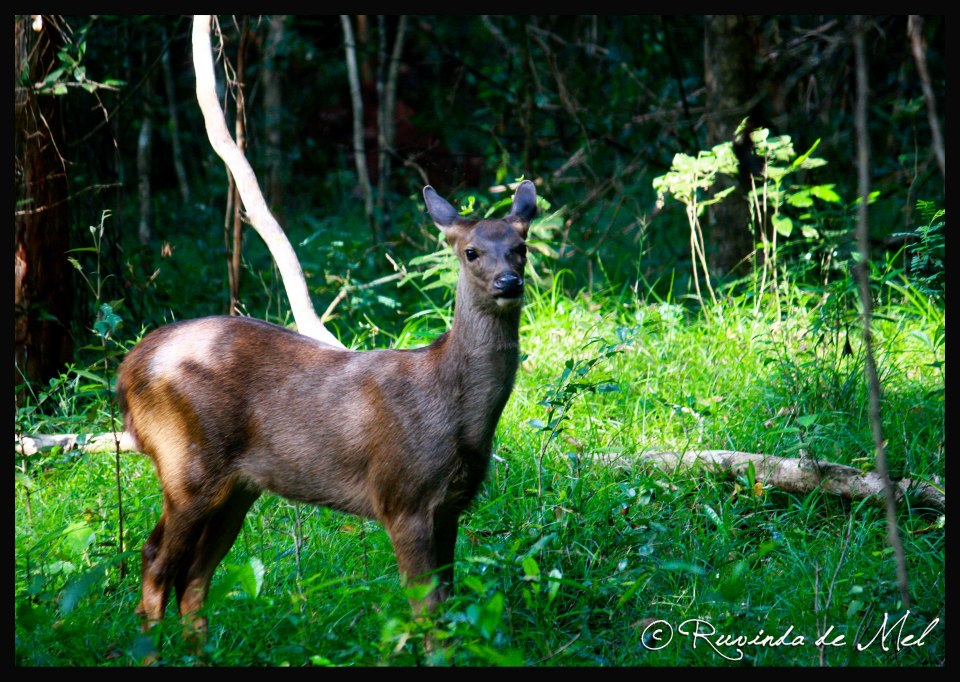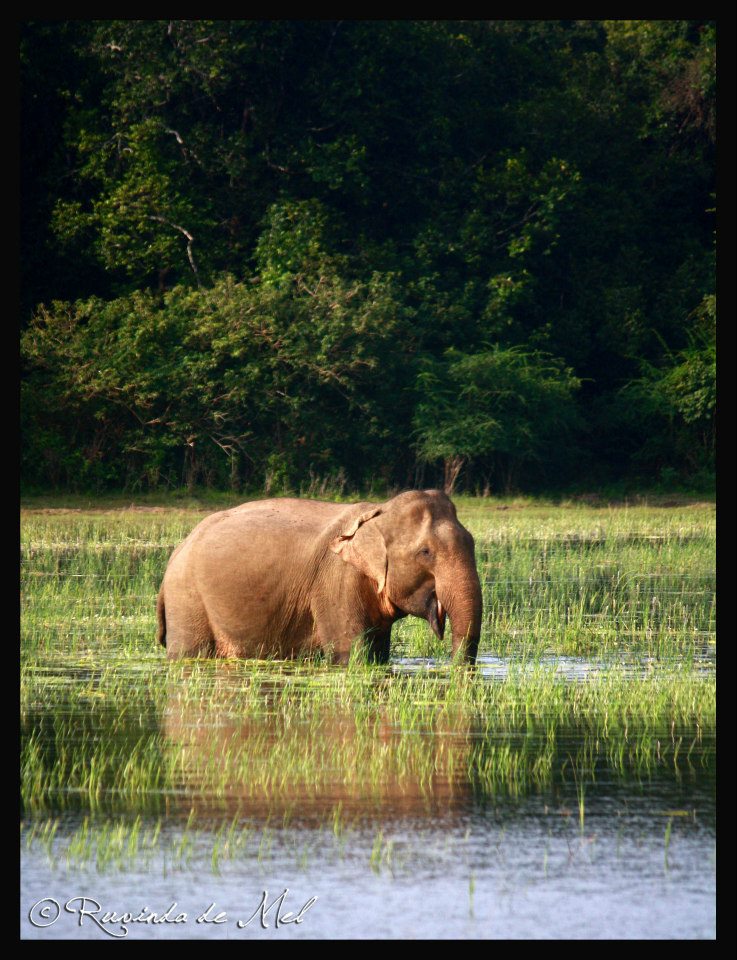We heard the langurs give their alarm call and saw the sambhur do the same. This tells us in quite a straight forward manner that it was in reaction to the sight of a threat. Even though monkeys have many an enemy, there are only two animals that could pose a threat to a fully grown male sambhur in our forests. One of them is the mighty crocodile and the other is the king of our forests; the leopard. Given that the nearest tank is nearly a mile away and this being a thick jungle and coupling with it the frequency and intensity with which the langurs called, we can be fairly certain that the cause for alarm in this case was a leopard. We saw the sambhur looking at the threat and pawing the ground for a while. Even though the leopard was in plain sight (to the sambhur) he didn’t turn tail and run. We also saw the sambhur’s gaze moving from right to left of the path. These morsels of data tell us that the leopard was not out hunting this morning, and therefore was in no need to conceal his presence. He was merely travelling from one destination to another and in the process crossed the path from right to left. We have now established, with considerable confidence, that a leopard has crossed the track within 70 yards from our position only by interpreting the language of the beings of the jungle. Let us now walk down that path to confirm our inference, and while doing so let us be weary. For, when dealing with leopards, it is prudent to expect the unexpected.
Forty yards down the new path we come across a set of pug marks travelling from right to left. The size and the unique characteristics of the pug marks confirm our suspicions. It certainly is a large leopard. Upon closer inspection, we see the pug marks are rather roundish as opposed to slightly oval in shape. This tells us that it was a male leopard. The larger pugs are of the forepaws and the smaller are from the hind and the latter being placed slightly behind the former at an even distance throughout the walk, tells us that the animal was walking at an even, unhurried pace which also coincides with the time duration of alarm calling and the sambhur’s head movement. Tracking has always been the activity which brought me the greatest pleasure in the jungle. It has enabled me to reconstruct events that happened, in some cases, many hours ago and thereby peer into the mysterious lives of these beautiful creatures. Having crossed the path the big cat has moved into the jungle. I cannot speak for you my friend, but I for one am not brave enough to follow a fully grown leopard into thick jungle on foot and unarmed. Therefore I must stress the need to continue our walk before you persuade me to join you on a brave but reckless endeavor.
We continue on our excursion and witness a Crested serpent eagle scrutinizing our every movement from its vantage point thirty feet up in a tree. We are greeted by a cacophony of calls ranging from the sweet melodies of a Tickell’s blue flycatcher to the harsh call of the Ceylon grey hornbill. A Barking deer (Olu muwa), with its beautiful chestnut brown pelage, that has been walking towards us, stops dead in its tracks upon sighting us. Even before we decide to reciprocate its actions it turns around and makes a dash for cover, uttering its characteristic alarm call which closely resembles a ‘bark’ of a dog. As we move forward the rustling of leaves accompany us and breaks the silence while the tree ferns growing on the ‘palu’ trees in full bloom adds unyielding beauty to the mysterious jungle.
We have now arrived at the edge of a ‘villu’: an expanse of water with grass growing in its midst. The first thing that greets our eyes and our hearts is the ocean of Dopartrium flowers forming a thick blanket of purple along the edge of the villu, that reminds me of a plush Persian carpet. At the center of the villu (a good hundred yards away) is a giant bull elephant calmly feeding on the grass. The behemoth seems to be in a content disposition and doesn’t seem to be inclined to charge at two well behaved humans. Thus reassured, we shall rest for a while under a ‘kohomba’ tree and observe all that is around us. Apart from the elephant that seems oblivious to our presence, there are egrets wading silently among the Dopartrium flowers waiting for an opportunity. Cormorants and Little grebes seem to glide on the water hardly creating any ripples. A lone Brahminy Kite soars quite low in wait of the unfortunate tilapia to break the surface of the water. The breeze continues to gently caress our faces while we sit here on the soft white sand.
The sun has now started to journey upwards in the blue sky and that is our cue to retrace our steps. A final glance over our shoulders show us the elephant to be still feeding, the cormorants to be still gliding and the villu to be still; beautiful. Moving along the familiar path we see that a bear has walked along it as well. His prints being juxtaposed on ours and the absence of bear tracks on the path when we walked along it in the morning tells us that the bear has passed this point after we had done so. Had we returned some time earlier we would either have had the good fortune of seeing a beautiful animal walking along a dimly lit jungle track, or the misfortune of being attacked by it. Having had a prior experience with a bear that was quite too close for comfort, I feel fortunate that we return now and not earlier.
An uneventful but magically peaceful hour later, we are now at the point where we began our walk and thus, have arrived at a parting of ways. You my friend, shall continue towards civilization and all the comforts it holds. I myself shall now turn back and shuffle along my own way. I hope we meet again someday so that we may yet again embark on another walk in the woods. For the jungle still holds enough mysteries to solve and more than enough lessons to be learnt by two eager students during the entirety of their lifetimes.


